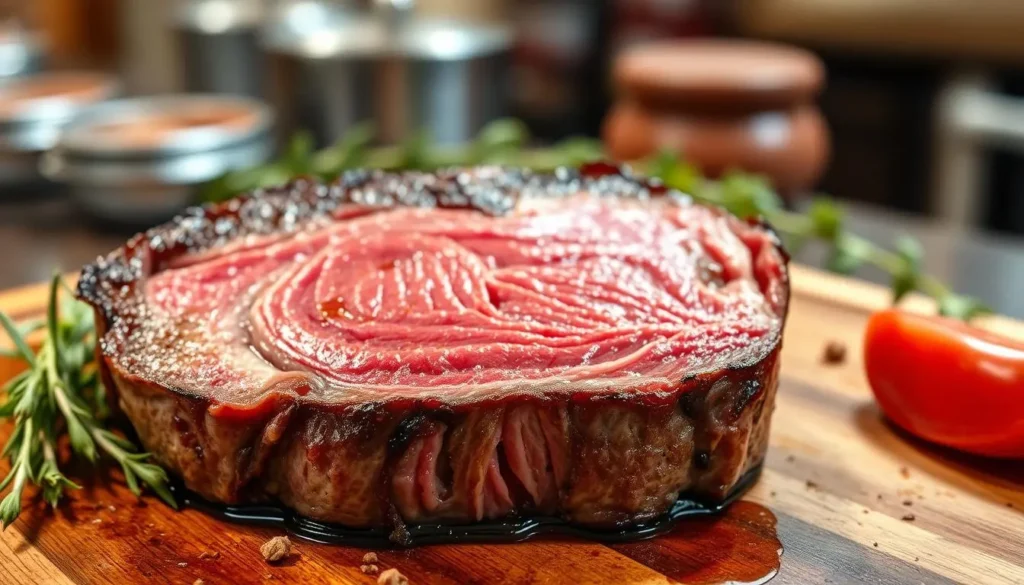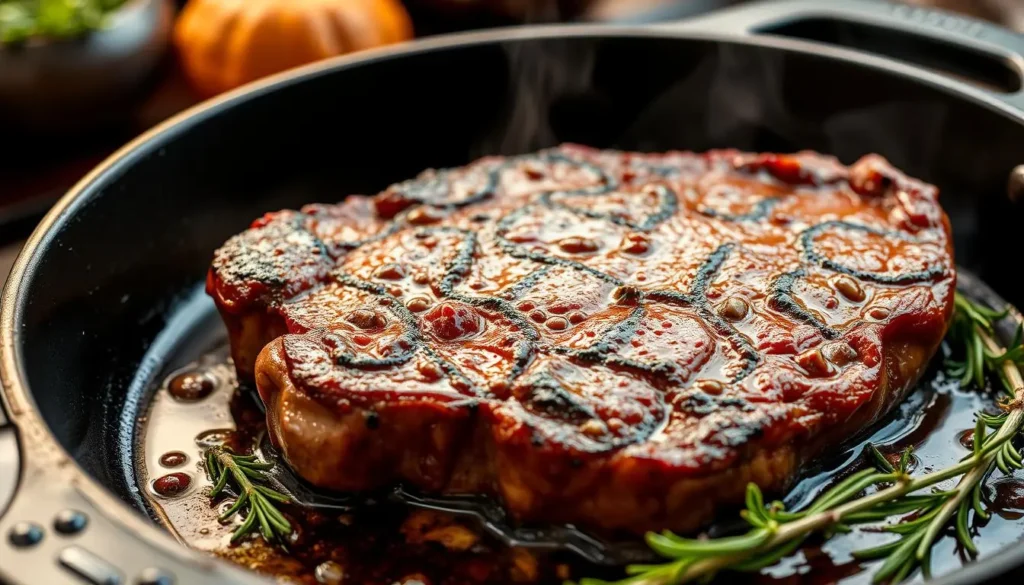Medium Rare Steak Temp
Medium Rare Steak Temp
Table of Contents
Ever wondered the perfect temperature for a mouthwatering, medium rare steak? We’ve got the ultimate guide for you. Learn how to make a juicy, flavorful steak that will delight your taste buds. Discover the secrets to a perfect medium rare experience in your kitchen,
Achieving the Ideal Medium Rare Steak Temperature
Cooking the perfect medium rare steak is an art. The key is to get the internal temperature just right. This makes the steak juicy and delicious. Whether you’re a steak expert or new to red meat, knowing the right steak doneness and steak internal temperature is crucial.
Rare Steak: 120°F to 125°F
For a truly rare steak, the internal temperature should be between 120°F and 125°F. The steak will have a deep red, almost purple center. It will be cool and very soft to the touch.
The rare steak temp ensures a tender, exceptionally juicy texture. It melts in your mouth.
Medium Rare Steak: 130°F to 135°F
The medium rare steak temp is between 130°F and 135°F. At this medium rare steak temperature, the center is warm, bright red, and incredibly tender. The fat and connective tissues have just begun to render.
This creates a truly sublime eating experience.

Medium Steak: 140°F to 145°F
If you prefer a more cooked steak, the medium steak temp is 140°F to 145°F. The center will be mostly pink, with a firm, juicy texture. The steak temperature guide says this is the upper limit for tenderness and juiciness.
Remember, the internal temperature of the steak will rise after it’s removed from the heat. So, remove the steak when it’s about 5°F below your desired steak internal temperature.
| Doneness | Temperature Range (°F) | Temperature Range (°C) | Appearance |
|---|---|---|---|
| Blue | 108-115 | 42-46 | Purplish-red, very cool center |
| Rare | 120-125 | 49-52 | Deep red, cool center |
| Medium Rare | 130-135 | 54-57 | Warm, red center |
| Medium | 140-145 | 60-63 | Mostly pink, firm center |
| Medium Well | 150-160 | 66-71 | Slightly pink center |
| Well Done | 160-170 | 71-77 | Little to no pink, firm center |
Understanding the steak temperature guide and the different steak doneness levels helps you achieve the perfect medium rare steak temp. This way, you can enjoy a truly mouthwatering dining experience.

Cooking Tips for a Perfectly Juicy Medium Rare Steak
Getting a perfect medium rare steak at home is an art. It needs focus and some special techniques. Start by drying your steaks and seasoning them well with salt and pepper. Then, heat a cast iron skillet over medium-high and add oil to the pan.
When the oil is hot, sear the steaks for 3-4 minutes on each side. This will create a nice crust. Use tongs to sear the edges for another 1-2 minutes on each side. After searing, lower the heat and add butter, garlic, and herbs to the pan. Spoon the butter over the steaks until they’re almost at your desired temperature, which is between 130°F and 135°F for medium rare.
Once the steaks are just right, take them off the heat. Let them rest on a cutting board, covered with foil, for at least 10 minutes. This step makes the steak juicy and tender.
| Steak Doneness | Internal Temperature | Cooking Time |
|---|---|---|
| Rare | 120°F to 125°F | 3 minutes total |
| Medium Rare | 130°F to 135°F | 4 minutes total |
| Medium | 140°F to 145°F | 5-6 minutes total |
| Medium Well | 150°F to 155°F | 6-7 minutes total |
| Well Done | 160°F and above | 8 minutes total |
By using these medium rare steak cooking tips, you can make a juicy, pan-seared steak every time. This works whether you’re using a cast iron skillet or grilling over high heat. With practice, you’ll become a steak temperature master in no time.
“The secret to cooking a perfect medium rare steak lies in mastering the art of temperature control and patience.”
The Science Behind Cooking Medium Rare Steak
Cooking a perfect medium rare steak is an art. It requires understanding the science of cooking. You need to know how to balance protein coagulation and fat rendering, while keeping the temperature just right.
Understanding Protein Coagulation and Fat Rendering
When a steak cooks, the proteins start to change. This happens when the meat hits 104°F (40°C). The meat then goes from soft to firm.
At the same time, the fats melt and spread their flavors. But, if the steak gets too hot, the proteins can overcook. This makes the steak dry and tough.
The right balance between protein and fat is key. It makes the steak juicy and tender, just like many people love.

Importance of Temperature Control
Getting the temperature just right is crucial for a perfect medium rare steak. Most people like their steaks at about 135°F (57°C). This temperature makes the proteins just right and the fats flavorful.
Using a meat thermometer is important. A quick 1-2 minute sear on each side and then finishing in a 425°F (218°C) oven is recommended for achieving a medium-rare steak. Letting the meat rest for at least 5 minutes before serving also helps keep it moist.
Knowing the science of cooking steak is essential. It helps you master the art of cooking a perfect medium rare steak. By controlling the temperature and cooking methods, you can make a juicy, flavorful steak that everyone will love.
Choosing the Right Cut for Medium Rare Perfection
At Rosebud Steakhouse, we know the secret to a perfect medium-rare steak. It’s all about picking the right cut of beef. Our team selects only the finest steaks, like ribeye, filet mignon, and New York strip. Every bite shows our skill in steak preparation.
The quality of the meat is crucial for a great medium-rare steak. We get our beef from top suppliers and age it carefully. This brings out the meat’s natural flavors and tenderness. We help our customers choose the best steak for their medium-rare treat.
Do you like the rich taste and soft texture of a ribeye? Or the tender, soft feel of a filet mignon? Rosebud Steakhouse can guide you. We focus on quality and detail. Every steak we serve is cooked just right, offering a mix of flavors that will make you want more.
FAQ
What is the ideal internal temperature for a medium rare steak?
The ideal internal temperature for a medium rare steak is 130°F to 135°F.
How do I ensure my steak is cooked to the perfect medium rare doneness?
To get your steak just right, take it off the heat when it’s 5 degrees shy of your target. It will cook a bit more after it’s removed.
What are the temperature ranges for different levels of steak doneness?
Here are the temperature ranges for steak doneness: Rare: 120°F to 125°F Medium Rare: 130°F to 135°F Medium: 140°F to 145°F Medium Well: 150°F to 155°F Well Done: 160°F to 165°F
What are the key steps to cooking a perfectly juicy medium rare steak?
For a juicy medium rare steak, follow these steps: 1. Dry the steaks and season with salt and pepper. 2. Heat a cast iron skillet with oil over medium-high. 3. Sear the steaks for 3-4 minutes on each side until brown. 4. Use tongs to sear the edges for 1-2 minutes. 5. Lower the heat, add butter, garlic, and herbs, and baste the steaks. 6. Remove the steaks when they’re almost at your desired temperature. Let them rest for 10 minutes before slicing.
What is the science behind cooking a steak to medium rare?
Cooking a steak to medium rare involves understanding how heat affects meat. Heat makes proteins coagulate and fats render, making the steak juicy and flavorful. But, if it gets too hot, it can dry out. So, it’s all about controlling the temperature to get that perfect medium rare.
What are the best cuts of steak for achieving the perfect medium rare?
For the perfect medium rare, go for ribeye, filet mignon, or New York strip. These cuts are top-notch and aged well, ensuring the best texture and flavor.

